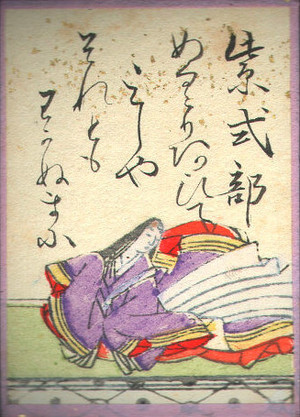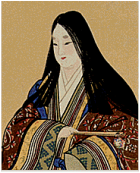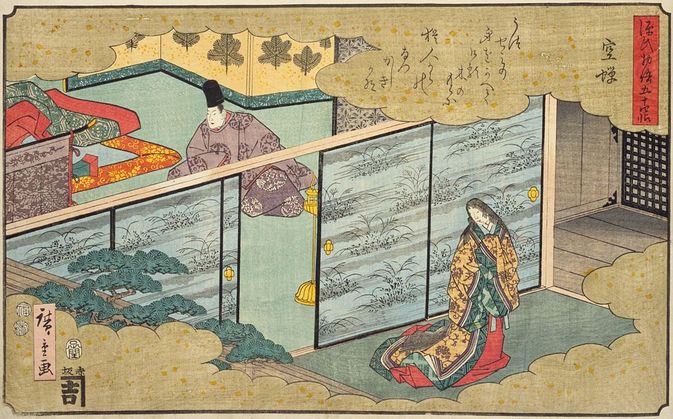Murasaki PoetryPoems in Waka form by Lady Murasaki Shikibu, celebrated author of the world's first novel, The Tale of Genji.
|
Poetry by Lady Murasaki
|
As life flows on,
who will ever read it-- this keepsake to her whose memory will never die? |
Tare ka yo ni
nagaraete mimu kakitomeshi ato wa kiesenu katami naredomo |
|
Chancing to meet again,
did I truly see you or, before I could tell, had you disappeared behind the clouds-- face of the midnight moon? |
Maguriaite
mishi ya sore tomo wakanu ma ni kumogakurenishi yowa no tsukikage |
|
Fretting and longing,
gazing at the moon across the western sea, it is a time of nothing but tears. |
Nishi no umi wo
omoiyaritsutsu tsuki mireba tada ni nakaruru koro ni mo aru kana |
|
As the song of the crickets
fades in the hedge, it is impossible to stop autumn's farewell; how sad they must be too... |
Nakiyowaru
magaki no mushi mo tomegataki aki no wakare ya kanashikaru kana |
|
Westward messages
following the moon, why would I forget to send news along with the drifting clouds? |
Nishi e yuku
tsuki no tayori ni tamazusa no kikitaeme ya wa kumo no kayoiji |
|
If I were to vanish away,
would you come seeking my name even unto the grave? |
Uki mi yo ni
yagate kienaba tazunetem kusa no hara o ba towaji to ya omon |
Poetry as CommunicationSometimes waka poetry was exchanged, especially among members of the court, as letters. A poem was sent to the intended. A skillful reply was returned, using elements or images from the first poem.
|
|
The Plea:
|
Deep in the dew
of these faraway hills maple leaves turn scarlet; I wish I could show you the color of my sleeves. |
Tsuyu fukaku
okuyamazato no momijiba ni kayoeru sode no iro o misebaya |
|
The Reply:
|
Raging in faraway hills,
the storm relentlessly sweeps away both scarlet leaves and dew, leaving no trace. |
Arashi fuku
touyamazato no momijiba wa tsuyu mo tomaran koto no katasa yo |
|
The Response:
|
Scarlet leaves, seduced
insistently by the storm, had no desire to fall anywhere save underneath the tree. |
Momijiba wo
sason arashi wa hayakeredo ko no shita narade yuku kokoro ka wa |
|
Paired Poems
|
|
The Plaint:
|
Frosted stiff by ice,
my writing brush cannot begin to draw you a picture of my feelings. |
Shimo kouri
tojitaru koro no mizukuki wa e mo kakiyaranu kokochi nomi shite |
|
The Response:
|
Though it flows not,
continue to write; your pain will float away like frost and ice on the water. |
Yukazu tomo
nao kakitsume yo shimo kouri mizu no ne nite omoinagasamu |
More Poems by Lady Murasaki
|
Write to me as often as
their wings inscribe the clouds, the brushing wings of the wild geese heading north, never stop writing. |
Kita e yuku
kari no tsubasa ni kotozute yo kumo no uwagaki kakitaezu shite |




